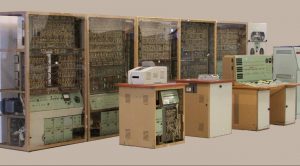Minsk-22 computer
Use
Solving scientific (mathematical) and (especially technical) research problems
Support for computer education
Solving special individual (military) tasks
The first copy was put into operation at the Computer Center of the Hungarian People's Army (MN SZK) in 1967. However, when they received a Minsk-32 machine in 1974 and moved to another location, the Minsk-22 remained in place and became the property of the Zrinyi Miklós Military Academy.
The second copy was received by the Cybernetics Laboratory (KibLab) of JATE in 1968; it operated there until 1974, and then in another computer center until 1979.
Another copy was in operation at the Hungarian Academy of Sciences (MTA SZTAKI ), the Beloiannisz Machine Factory, and Infelor; the interesting thing about the latter is that the main reservoir was expanded to 16 KW through its own development.
Structure
Central unit
Word processing machine: 37 bpW
The structure of the machine is logically identical to that of the Minsk-2
- control unit:
- instruction decode register (7 bits)
- address counter register (PC, 13 bits)
- main store:
- ferrite ring RAM, up to 8 KW
- cycle time 4 μs
- calculator:
- 3 main registers: AC (accumulator), R1 and R2
Periphery
- backup:
- magnetic tape, 800 kW (1” non-standard, quite unreliable operation)
- external devices
- line printer with writing bar, 60 lpm
- rotary cylinder line printer 100 lpm, for printing alphanumeric data
- serial number printer: for printing numeric data, 10 decimal digits + sign
- punched card reader, 80 columns
- FACIT punched tape reader (KibLab)
Operation
The machine worked with two-address instructions, and the value of the address counter — with the exception of jump instructions — increased by 1 after each instruction was executed, thus pointing to the next instruction.
Instruction structure:
- operation code (7 bits)
- index (4 bit)
- two address parts (13-13 bits)
The R1 register received the first factor from the first address and stored the result there; the second factor was placed in AC from the second address, or from the R2 register if it was the result of a previous operation.
Otherwise, the R2 register acted as an extension of the R1 register for long operations (multiplication, division)
The storage of the result and the data flow between the main memory and the secondary memory, or output devices (printer, punched card) were realized either through the R1 or AC register.
Thanks to the upgraded technology, the average operating speed is ∼10 kips
Minsk-22 operated very reliably, operating 24 hours a day, 5, 6, and sometimes 7 days a week; with a utilization rate of 90% over the total on-time (MTBF 151.2 hours)
Program set
- operating system: developed at JATE KibLab
- compilers:
- Factory default only Engineer Autocode
- Fortran
- Cobol
- Algol (all three acquired by JATE KibLab)
- Algol68 (KibLab development)
The rather large factory subroutine library was used for performing technical and scientific calculations, so it could hardly be used to solve tasks arising at JATE (mathematical linguistics, operations research, translation programs).
The programs used in practice were developed by users, according to their own goals, and their documentation was not officially made public.
Historical curiosities
The blog titled Hungarian People's Army and the Computer describes in detail the "top secret" expansion of computer technology in the field of Hungarian national defense: MN and the Computer.
The 2nd copy was purchased by OMFB for KibLab, to support the applied mathematics training launched at the pioneering initiative of László Kalmár, to replace the then 9-year-old M-3 computer.
For example, a student solved a simulation of Kalmár's fictitious machine as a thesis.
(The fictitious machine was an "imaginary" computer defined for the education of programmer-mathematicians, in one-, two-, or three-head versions, combining the essential features of real machine types. Thus, anyone who learned to program the fictitious machine could more easily learn to use a concrete computer.)
Created: 2016.04.20. 23:29
Last modified: 2025.02.19. 17:00

